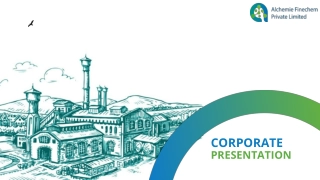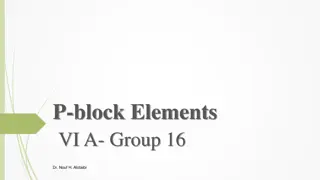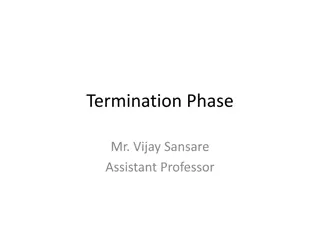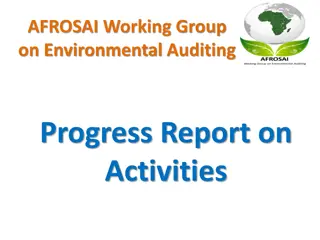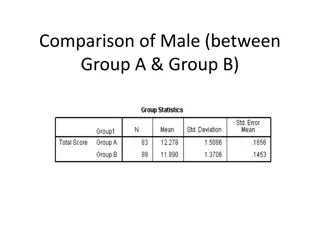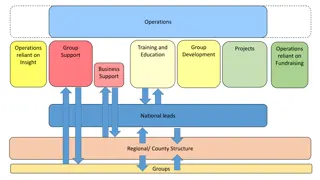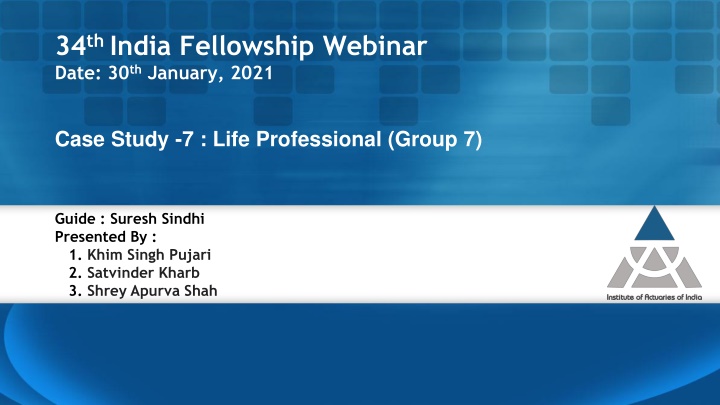
Challenges in Addressing Negative IRR in Life Insurance: Case Study Analysis
As the appointed actuary of a private life insurance company facing policyholder IRR issues, explore the reasons, consequences, and potential solutions. The case study delves into product design flaws, low business volume impact, poor investment performance, and underwriting issues. Discover how to navigate regulatory challenges and propose a strategic course of action.
Download Presentation

Please find below an Image/Link to download the presentation.
The content on the website is provided AS IS for your information and personal use only. It may not be sold, licensed, or shared on other websites without obtaining consent from the author. If you encounter any issues during the download, it is possible that the publisher has removed the file from their server.
You are allowed to download the files provided on this website for personal or commercial use, subject to the condition that they are used lawfully. All files are the property of their respective owners.
The content on the website is provided AS IS for your information and personal use only. It may not be sold, licensed, or shared on other websites without obtaining consent from the author.
E N D
Presentation Transcript
34th India Fellowship Webinar Date: 30thJanuary, 2021 Case Study -7 : Life Professional (Group 7) Guide : Suresh Sindhi Presented By : 1. Khim Singh Pujari 2. Satvinder Kharb 3. Shrey Apurva Shah
Case Study You are appointed actuary of a private sector life insurance company in India around 2017. The regulator has asked you to submit details of the IRR given to the maturing policyholders in participating products over the last 3 years & the targeted IRR for policies maturing in the next 2 years. You realized that large number of policyholders have got negative IRR. You further investigated & found that the products were designed with negative IRR at maturity and even benefit illustrations show negative IRR. Regulator has not issued any specific directive in this regard. There is very little surplus in the participating fund and shareholders have told you categorically that they are not able to infuse any capital. What is the course of action that you plan to take and highlight how you would handle the professional/regulatory issues? www.actuariesindia.org
Agenda Objectives What went wrong? Pros and Cons of not making the IRR positive Pros and Cons of making the IRR positive Key issues to be considered Investigations required Communication and Advice to Board of Directors Proposed Course of Action Conclusion Q & A References www.actuariesindia.org
Objectives Consider the pros and cons of making IRR positive Consider the key issues that may be faced before deciding any course of action Course of action that can be taken considering all stakeholders www.actuariesindia.org
What went wrong? www.actuariesindia.org
What went wrong? Product Design & Pricing High risk cover product- Death Sum Assured is 2 or 3 times of Maturity Sum Assured Riders attached to the policies leading to a negative IRR as there will be no payout related to rider premiums at maturity Product IRR not checked at the designing stage for all ages & policy term combinations Companylevel Factors Low New Business volume that led to high per policy expenses- lower bonuses Poor investment performance for par portfolio in the past - lower bonuses Poor underwriting- Death claims higher than expected www.actuariesindia.org
What went wrong? (Contd) Sales & Marketing Policies sold to higher ages individuals - where death cost erodes the maturity benefit due to higher mortality loading Lower ticket size policies sold not enough surplus generated in the Par fund Product was designed to be protection oriented but mis-sold by sales force as savings product Product sold to different market than the targeted market e.g. designed for HNI customers but sold to all income groups www.actuariesindia.org
Pros and Cons of Continue making maturity payment with a negative IRR Pros: No financial strain on the Par fund No impact on shareholders profits Continuing policyholders will not have to compromise on their future bonuses and maturity payouts Cons: Unfair to the policyholders with negative IRR Bad publicity and increase in legal cases/policyholder complaints Increase in per policy level expenses due to increase in surrenders and lower new business volumes. This may have an impact on other lines of business as well and hence reducing future profitability www.actuariesindia.org
Pros and Cons of making the IRR positive Pros: Improved brand image as it will show that company values its policyholders and treats them fairly Competitive edge over other companies Easy to raise additional capital in the long-term Cons: Reduction in company s surplusconsequently it will be required to raise additional capital from other sources Impact on continuing policyholders It would be considered unfair by them as their future bonus payouts will be impacted Shortage of capital for writing new business or expansion plans due to higher payout to matured policies and higher reserve for inforce policies www.actuariesindia.org
Key issues to be considered www.actuariesindia.org
Issues to be considered while deciding course of action Policyholders Policyholders Reasonable Expectations (PRE) set at the point of sale as well as during course of the policy Providing a special bonus or ex-gratia amount should not create PRE i.e. it should be communicated clearly that special bonus perceived to be irregular by the policyholders Treat customer fairly while declaring bonus Already matured policies to be compensated and treated in line with the course of action decided for the maturing policies www.actuariesindia.org
Issues to be considered while deciding course of action Policyholders (contd ) Any action may lead to complaints and legal cases e.g. paying ex-gratia amount may lead to court cases by other policyholders demanding similar payouts If decision to make positive IRR on maturing policies getting delayed, this may lead to higher surrenders and thus higher per policy expenses may aggravate the situation of negative IRR If the company chooses to make the IRR positive, it will be cross-subsidised with the future payouts of continuing policyholders IRDAI (Protection of Policyholders Interest) Reg., 2017 Provide all material information in respect of a proposed cover to the prospect to enable the prospect to decide on the best cover that would be in his interest Inform participating policyholders, at least once in a year, the bonus accrued to their policies Proper procedures and effective mechanism to resolve complaints and grievances of policyholders www.actuariesindia.org
Issues to be considered while deciding course of action Insurance company Company reputation the company needs to resolve the matter at the earliest as taking no action will lead to bad publicity Impact on future New Business - if decided to set aside reserves to make the IRR positive, this will tie up capital and hence the company will have restrictions on writring new business The negative IRR would have adverse impact on new business and may lead to mass surrenders if the issue is not resolved Ensure matter is resolved in a timely manner as regulatory interventions will increase when higher complaints received from policyholders Solvency of the company to be considered while declaring special bonuses or making payout to matured policyholders IRDAI (Appointed Actuary) Regulations, 2017 Ensure the solvency of the insurer at all times Ensure that the policyholders reasonable expectations have been considered in the matter of valuation of liabilities and distribution of surplus www.actuariesindia.org
Issues to be considered while deciding course of action Benefit Illustration The company should review the contents of sales literature, benefit illustrations and policy documents as these build the Policyholders reasonable expectations At the point of sale of the policies that have matured, the benefit illustration was shown at 6% and 10% gross investment return but currently it is shown at 4% and 8% When calculated at 4% and 8% more number of policies will have a negative IRR as compared to 6% and 10%. So it means there will be higher number of policies in future with negative IRR at maturity shown in the benefit illustrations APS -5 : AA and Principles of Life Insurance Policy Illustrations An insurer shall review the assumptions in its sales illustrations at least once in a year and where the assumptions are no longer valid, revise the sales illustration www.actuariesindia.org
Investigations required www.actuariesindia.org
Investigations required for deciding course of action Analysis of data Quantify the amount required to provide positive IRR to already matured policyholders Check IRR at maturity for all policies of the portfolio based on vested bonus and proposed bonus rates for future years and quantify the deficiency in advance. This will give an idea of any additional capital requirements. Quantify the reserves that needed to be set aside for policies maturing in future with negative IRR to make it positive Age-wise/Sum Assured wise - Whether policy is sold to customers whose age at entry is high leading to higher death benefit cost and fall in IRR to understand the demography of affected policyholders Whether rider attached to these policies- Has cost of providing others benefits led to negative IRR? www.actuariesindia.org
Investigations required for deciding course of action Asset share Project forward earned asset share of existing policies & compare with projected maturity values to quantify the shortfall for positive IRR Identify the main item(s) causing strain on asset share- death cost, expenses Bonus Distribution Policy Investigate if a switch from the current bonus policy will help in giving positive IRR to the continuing policies e.g. does increasing current TB rates and gradually reducing current RB rates (considering PRE) help in achieving better investment returns and lower guarantee reserve ? Calculate the special reversionary bonus rates for each product that needs to be given to the affected policyholders, if required IRDAI (Non-Linked Product) Regulations, 2013 The insurer shall maintain the asset shares, at policy level The detailed working of the asset share, the expensed allowed for, the investment income earned on the fund etc which are represented in the asset share shall be approved by a With - Profits Committee www.actuariesindia.org
Investigations required for deciding course of action Quantify Estate Investigate if affected policyholders have any right on the estate (whether there was any under distribution of surplus in the past) and quantify, if they have rights Investigate how estate distribution impact solvency margins and restrictions on investment policy Other investigations Investigate if smoothing of maturity payout causing negative IRR if any, do not smooth for these products Check whether underwriting policy is appropriate for these products - actual experience converges to pricing assumptions. Identify the sources of surplus or deficit of affected policies e.g.: mortality, expenses, investment performance and persistency, in order to focus on any source leading to negative IRR and fill any gaps www.actuariesindia.org
Identifying sources of surplus The sources of surplus that can be used to make IRR positive by declaring special reversionary bonus and an ex-gratia amount to matured policyholders: Mortality / morbidity profit emerging from riders attached with Par products Profits arising from better experience in non-par business Profits arising from already reduced paid up policies as these will not be eligible for any future bonuses unless reinstated Profits arising in future from the lapsed policies in Par business Profits arising from surrender of policies i.e. excess of asset shares over surrender payouts Profits arising from maturity of positive IRR policies i.e. excess of asset shares over maturity payouts Profits due to lower mortality than expected Profits due to lower expenses than expected Investment profits arising from good investment performance of the Par fund www.actuariesindia.org
Communication and Advice to Board of Directors Communicate the results of all investigations to Board of Directors Highlight to the Board the need to modify the current practice i.e. taking no action for negative IRR policies Highlights the key issues that the company may face by making IRR positive for matured policies and maturing in future Based on the identified sources of surplus, provide advice on how to increase the surplus of the Par fund and utilize it to provide a positive IRR to affected policyholders Suggest the course of action on treatment of policies with a negative IRR across all generations of policyholders Professional Conduct Standards (by IAI)- V.3-para 2.1 Influencing those in power to protect and enhance public interest www.actuariesindia.org
Proposed Course of Action www.actuariesindia.org
Proposed Course of Action 1. Make IRR positive by payment of ex-gratia amount under matured policies 2. Make IRR positive by paying higher terminal bonus or special reversionary bonus under inforce policies 3. Review of investment policy 4. Review the bonus distribution policy 5. Review of surrender value 6. Special arrangements with financial institutions / reinsurers 7. Reduction in shareholders share in surplus www.actuariesindia.org
Make IRR positive by payment of ex-gratia amount under matured policies Make the payment of the difference between total premiums paid and maturity amount paid for policies matured during last 3 years where IRR is negative at maturity based on the investigations Decide the mechanism for payment of difference where- o Policyholders might have already died (after getting maturity payment) - pay to his/her beneficiary o Bank accounts of affected policyholders might have been closed, obtain new bank account details o Resolve any legal cases through out of court settlements www.actuariesindia.org
Make IRR positive by paying higher terminal bonus or declaring special reversionary bonus under inforce policies Compare the expected maturity value with total premiums paid for policies maturing in the future Increase the terminal bonus rates or declare the special reversionary bonus so that the IRR on maturity is positive The special reversionary bonus has to be communicated very clearly to the policyholders so that it does not build an PRE The company will need to hold additional reserve for negative IRR policies to make it positive IRDAI (ALSM) Regulations, 2016 The level of benefits shall take into account the reasonable expectations of policyholders (with regard to bonuses, including terminal bonuses, if any) and any established practices of an insurer for payment of benefits www.actuariesindia.org
Review of Investment policy The AA can review and suggest to modify the investment strategy within the framework of Investment Regulations, since the negative IRR can be due to poor investment performance Leverage the scope of enhancing investments returns with appropriate investment strategy and this can also compensate for other sources that cause a deficit This can be achieved via rebalancing of asset mix i.e. more investment in equity where expected return is higher IRDAI (Investment) Regulations, 2016 Investment allowed in Non- Linked Life Insurance Business:- Central Government Securities - Not less than 25% Central Government Securities, State Government Securities or Other Approved Securities - Not less than 50% (including above) Approved Investments and Other Investments - Not exceeding 50% Other Investments - Not exceeding 15% Investment in housing and infrastructure - Not less than 15% www.actuariesindia.org
Review the bonus distribution policy The AA should also review and suggest to the Board changes on the bonus distribution policy Defer the bonus allocation by switching more towards terminal bonuses and gradually reducing the reversionary bonuses Defers the guarantees that will get attached to the policy The increase in available capital generated due to deferment should be used for an aggressive investment strategy and write profitable new business www.actuariesindia.org
Review of Surrender Value Reduce the special surrender value scales with the prior approval of the regulator The additional surplus arising from this can be used to wipe out the negative IRR of maturing policyholders GN -6 : Management of With-Profits Fund When considering surrender values, the AA should have regard to: Whether and to what extent surrender surpluses are being used to support the payouts to policyholders who hold their policies for longer. Where surrender surpluses are being used to support payouts to policyholders who hold their policies for longer, the AA should consider if the method of surplus distribution, either reversionary or terminal bonus, is well-matched to the source of surplus www.actuariesindia.org
Special arrangements with financial institutions/ reinsurers If the company is not able to inject additional capital internally, then it should enter into a special arrangement with financial institutions or reinsurance companies (subject to special regulatory approval) to accept advance finance from these institutions. The advance can be used to pay special bonuses to negative IRR policies and in return the company can share a % of the shareholders future profits This arrangement is like a securitisation where by taking advance from the financial institutions will not create obligatory liability but the future repayment from shareholders share of profit from par business is contingent upon the bonus declared and the number of policies in force each year at the time of bonus declaration This is also a cheaper way to raise additional capital as the shareholder will not need to infuse any capital www.actuariesindia.org
Reduction in shareholders share in surplus The company can reduce the shareholder s share of profit. This will increase the surplus of the with-profits fund and can be used to make the IRR positive for maturing policies This will require prior approval from the Regulator and may not go down well with the shareholders IRDAI (Distribution of Surplus) Regulations, 2002 Shareholders share in surplus should be 1/9th of the surplus allocated to participating policyholders An insurer cannot allocate exceeding 10% of the surplus to its shareholders An insurer is required to obtain prior approval of the IRDAI in case where the allocation of surplus to Shareholders is not the 1/9th of the surplus allocated to participating policyholders www.actuariesindia.org
Conclusion Meeting the policyholders reasonable expectations is one of the key responsibilities of the Appointed Actuary of a life insurance company The Appointed Actuary should evaluate the professional and regulatory issues before taking any decision Before taking a decision, it is crucial to consider its overall implications on all stakeholders of the company Clear communication is important to ensure to the policyholders and other stakeholders are aware of the key issues and implications of any decision taken www.actuariesindia.org
Questions & Answers Thank You
References www.actuariesindia.org
References Insurance Act and IRDAI Regulations IRDAI (Distribution of Surplus) Regulations, 2002 IRDAI (ALSM) Regulations, 2016 IRDAI (Non-Linked Product) Regulations, 2013 IRDAI (Appointed Actuary) Regulations, 2017 IRDAI (Protection of Policyholders Interest) Regulations, 2017 APS & GN APS -1 GN - 6 APS-5 Professional Conduct Standards www.actuariesindia.org
IRDAI (Distribution of Surplus) Regulations, 2002 Life Fund Life fund to be maintained separately for Participating policyholders, and Non- Participating policyholders If life fund not maintained separately, the life fund maintained by insurer shall be for the benefit of the participating policyholders only Procedure for distribution of surplus A life insurer may reserve a part of the actuarial surplus to its shareholders, which shall be: 100%, in case of a life fund maintained for non-participating policyholders; 1/9th of the surplus allocated to policyholders in case of a life fund maintained for participating policyholders www.actuariesindia.org
IRDAI (ALSM) Regulations, 2016 The gross premium method of valuation Where benefits payable shall also include future bonuses including terminal bonuses (consistent with the valuation rate of interest) The level of benefits shall take into account the reasonable expectations of policyholders (with regard to bonuses, including terminal bonuses, if any) and any established practices of an insurer for payment of benefits. www.actuariesindia.org
IRDAI (Non-Linked Product) Regulations, 2013 With Profit Fund Management The Appointed Actuary shall clearly demonstrate in the Actuarial Report and Abstract, the appropriateness and prudence in debiting of expenses to with profits funds vis-a-vis other funds reducing the cross-subsidy between various groups of with profit policyholders overall financial management of with profits funds and governance of with profits funds. Asset Share The insurer shall maintain the asset shares, at policy level The detailed working of the asset share, the expensed allowed for, the investment income earned on the fund etc which are represented in the asset share shall be approved by a With -Profits Committee www.actuariesindia.org
IRDAI (Appointed Actuary) Regulations, 2017 Ensure the solvency of the insurer at all times Draw the attention of management to the actions required to be to avoid- Any contravention of the Act or Prejudice to the interests of policyholders Ensure that the policyholders' reasonable expectations have been considered in the matter of valuation of liabilities and distribution of surplus to the participating policyholders Actuarial advice in the interests of the insurance industry and the policyholders Informing the Regulator in writing of his or her opinion, within a reasonable time, whether, the insurer has contravened the Insurance Act, 1938 or any other Acts: the contravention is of such a nature that it may affect significantly the interests of the owners or beneficiaries of policies issued by the insurer www.actuariesindia.org
IRDAI (Protection of Policyholders Interest) Reg., 2017 Board approved policy for protection of policyholders interests which shall at the minimum, include - steps to be taken to prevent mis-selling and unfair business practices at point of sale and service steps to be taken to ensure that the prospects are fully informed and made aware of the benefits of the product and the terms and conditions of the product Provide all material information in respect of a proposed cover to the prospect to enable the prospect to decide on the best cover that would be in his interest Inform participating policyholders, at least once in a year, the bonus accrued to their policies Proper procedures and effective mechanism to resolve complaints and grievances of policyholders www.actuariesindia.org
APS-1: Appointed Actuary and Life Insurance Business Ensure that the life insurance business is conducted on sound financial lines Responsibility to look after the reasonable expectations of the company s policyholders, having regard to- the broad nature of the company, and its approach to the treatment of policyholders both individual and as a group vis- -vis shareholders Take all reasonable steps to ensure that new policyholders are not misled with regard to their expectations Determine the amount of surplus arising and advise on its equitable allocation between with profits policyholders and shareholders www.actuariesindia.org
GN-6: Management of participating business Asset Share Grouping of homogeneous policies Separately determined for each policy grouping Used to guide in the determination of bonus rate by setting the bonus scale such that - the ratio of the asset share to the surrender value or maturity value lies within a certain specified range the ratio of the asset share to the gross premium valuation lies within a certain specified range www.actuariesindia.org
GN-6: Management of participating business Smoothing of payouts Points to be considered by Appointed Actuary in smoothing of benefits - whether there is a genuine reduction in the volatility of payouts whether all policyholders are treated fairly whether there is a significant increase in the risk of insolvency Consider the treatment of surpluses or deficits arising from the smoothing of maturity values, in particular whether they are shared with the surviving asset shares or with the estate, in accordance with policyholders reasonable expectations Non-Par business written on par funds Pricing of non-par products should be fair and follow actuarial principles pricing of non-par products should not put undue strain on the fund Consider the impact of writing new business on existing policyholders www.actuariesindia.org
APS-5: AA and Principles of Life Insurance Policy Illustrations Main objective to educate the potential customer and assist in proper understanding of the features of the product Illustrations should be consistent with the terms and conditions of the product, wording in the policy document and company practice Illustration should clearly distinguish between guaranteed and non- guaranteed benefits Review the assumptions in its sales illustrations at least once in a year and where the assumptions are no longer valid, revise the sales illustration Illustrations should not be used as a tool to achieve a competitive edge in the market place www.actuariesindia.org
Professional Conduct Standards Professional Code of Conduct Standards by IAI requires: Obligation to serve public interest Debate on matters of public interest Influencing those in power to protect and enhance public interest Must not act in a manner, which denigrates its reputation or impugns its integrity Must ensure that their publicity, and any publicity by others on their behalf, is appropriate to the profession Advice should normally include sufficient information and discussion www.actuariesindia.org

